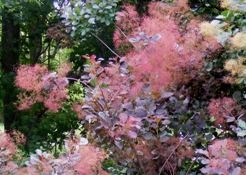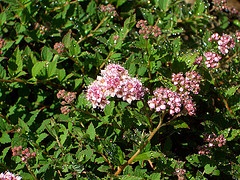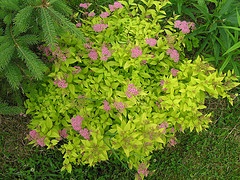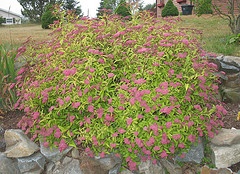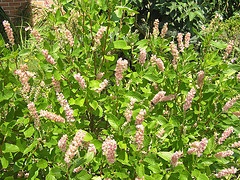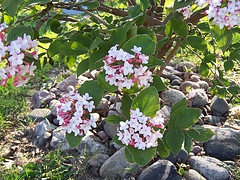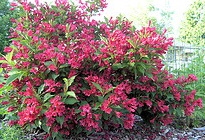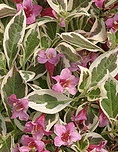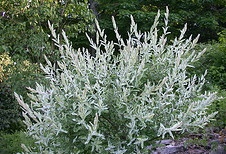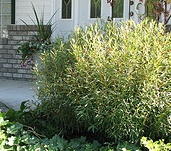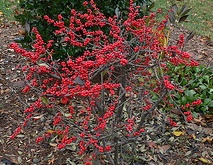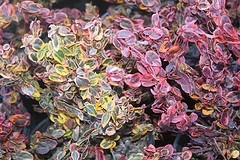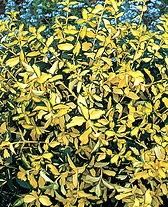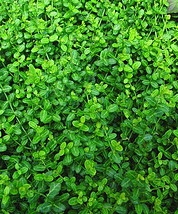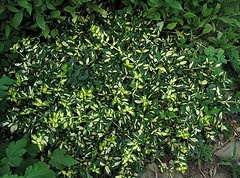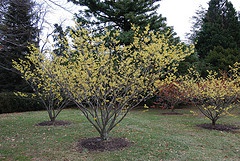Best Performing Shrubs
Rhododendron: Part to full shade Hardy in zones 4-7 Flowering shrub. Like the Azalea, no Rhododendron is hardy north of zone 4. Again, a few varieties have been bred to withstand the northern cold. Smaller varieties of Rhododendron, 'Yaku Princess' (Azalea) and the newer 'Firestorm' are also hardy up to zone 4. There are an incredible number of cultivars hardy enough to grow in zones 5-7. The ‘P.J.M’ varieties are evergreen as well as some of the ‘Girard’ azaleas. Winter sun and wind can damage the evergreen foliage, so select an appropriate spot (keeping in mind sun and wind patterns are not the same summer to winter). Rhododendrons are shallow rooted and should not be planted too deep. They prefer a cool, moist organic soil and are not tolerant of dry periods, make sure they get enough water. They do require acid. Acidic fertilizers made for rhododendrons will help, yellowing of the foliage is an indicator of low acid. Rhododendrons continue to grow well into autumn and are susceptible to early freeze damage. Water thoroughly until the ground freezes to allow the plant to properly acclimate to winter. (Also see the Azalea listings.)
'P.J.M.' (R. carolinianum x dauricum) is one of the hardiest of the hybrids. It is a small leafed variety that prefers well-drained acidic soil with even moisture. The bushy plant blooms heavily with pink flowers early in spring. Blooming begins at an early age, unlike many that need a few years to mature before blooming. Glossy dark leaves turn mahogany in winter, holding on most, if not all of winter. Grows to 6 feet high and 7 feet wide in part shade, but is more sun tolerant than large leaf cultivars, but should be protected from winter sun. Hardy in zones 4-7.
‘Northern Starburst’ is an improved, much more sturdy, variety of ‘P.J.M’. It is an early bloomer, in May, with strong stems. Clusters of mauve flowers have more substance than the ‘P.J.M.”. It has a compact growing habit that reaches 4-5 feet high and 2-5 feet wide. Leaves are thick and leathery, turning mahogany in autumn. Grows well in sun to part shade. Hardy in zones 4-7.
‘Haaga’ is one of the Marjatta hygrids from Helsinki, Finland. It is one of the best large leaf Rhododendrons for the north, bred from a very tough Korean species. ‘Haaga’ is a super hardy upright shrub with dark green evergreen foliage. Dark pink flower buds appear in May and June, and open to a lighter pink with dark streaks. It must have excellent drainage, mulch and peat moss soil additive. It will not do well in wind. It prefers shade to part shade and may reach 5-7’ tall and 4-5’ wide. Hardy in zones 3-8.
Smokebush: (Cotinus coggygria) Full Sun Hardy in zones 4 or 5 to 8 Flowering shrub. Smokebush is a large shrub with an upright, spreading habit that may be single or multi-stemmed. They are very tolerant of hot, dry sites and do well in poor, even gravely soils. Soil must be well drained. Establishing and transplanting easily, Smokebush is excellent for difficult sites. Most commonly used is ‘Royal Purple’, with its’ velvety purple leaves and smoky beige flower, it creates a dramatic specimen plant. Although this variety is not fully hardy in zone 4, the warmer, southern parts of the zone, near 5, work quite well. Reaches 8-10’ tall and wide. The hardiest of the purple leaved Smokebush is ‘Nordine’, but still may not make it in the coldest areas of zone 4. It holds it’s purple color well all season. Fall foliage is yellow orange. ‘Golden Spirit’ has a denser habit with bright yellow green leaves and vivid orange red fall color. The smoky flowers are tiny pink. A little smaller in size, ‘Golden Spirit’ grows to 8’ tall and 6’ wide. ‘Grace’ is the largest at 15-25’ tall, and 8-15’ wide. Foliage is purple in spring, maturing to blue green with pale reddish tones. Mid to late summer, large smoky pink flowers cover the bush.
Spirea: Full sun Hardy in zones 4-8 Flowering shrub. One of the easiest flowering shrubs to grow, and many varieties offer many bloom and leaf colors. All have bright floral displays in spring. Many have wonderful autumn foliage with rich vivid leaf colors. They generally grow quickly retaining a nice shape, but can, and should be pruned after each flowering to produce another round of blooms. Spirea prefers moist well drained soils, but will tolerate dry conditions. Will tolerate a variety of soil conditions, but a high alkaline soil may cause yellowing of the leaves, an acid fertilizer used for rhododendrons may help. Easily hardy in zone 4, with good success in zone 3.
‘Alpina’ or ‘Daphne Spirea’ (Spiraea japonica) ‘Alpina’ has small blue green leaves that grow on short wiry branches. Clusters of light pink flowers appear in June, and will rebloom if spent blooms are removed. Remains quite small, reaching only about 12” high and 2-3 feet wide. Perfect for tucking in as an accent or bordering a garden. Grows well in full sun to part shade. Hardy in zones 4-8.
'Anthony Waterer' (Spireaea x bumalda) has pinkish red flowers from early summer into the fall. Foliage is maroon green and turns reddish purple in the fall.. It grows to about 3 feet high and 4-5 feet wide. Will do well in full sun to part shade. Mass plantings produce a sea of rosy blooms, or makes a well behaved low hedge. Hardy in zones 4-8.
'Goldflame' (Spiraea x bumalda) flowers are crimson with leaves that start green gold, turn yellow, then orange-bronze by fall. New blooms appear all summer. Growing habit is low and nicely mounded. Reaches 3 feet high and 3-4 feet wide. Prefers full sun. Hardy in zones 3-8.
'Goldmound' (Spiraea japonica) is similar to the ‘Goldflame, but remains smaller, at about 2-3 feet. It’s smaller size makes it an ideal foundation planting, never outgrowing it’s space. Pink flowers will recur throughout the summer if spent blooms are sheared. Fall foliage is yellow-gold. Contrasts beautifully with dark green or blue green shrubs or evergreens. Full sun. Hardy in zones 3-8.
'Little Princess' (Spiraea japonica) blooms in a paler pink, with medium green foliage. Growing habit is low and mounding, also making it excellent as a foundation planting or in a border garden. Shear spent flowers to encourage reblooming. Fall foliage is dark burgundy red. Grows to about 1 or 2 feet high and 3 feet wide. Will do well in full sun to part shade. Hardy in zones 3-8.
‘Bridalwreath’ (Spiraea x vanhouttei) ‘Bridalwreath’ is a distinctive spirea with arching branches. It makes an excellent specimen plant if you have the room. It grows 6-8 feet and spreads to 12 feet and is covered with white blooms in spring. Full sun produces the most flowers, but will grow well in some shade. Prune back up to one third every year after blooming for best blooming next year. Will adapt to most soils, but prefers well drained. The leaves turn plum-green in fall. Hardy to zone 4 with good results in zone 3. Full sun Hardy in zones 4-8.
Summersweet: (Clethra anifolia) Full sun to shade Hardy in zones 4-9 Flowering shrub. An upright shrub with rounded to oval shape. When planted in shade may lack foliage at the base. Foliage is dark green, turning yellow to golden brown in autumn. Fragrant spires of blooms in mid to late summer, with fruit capsules in autumn. The shrub is late to leaf out in spring, so be patient. They are also slow to establish, and may experience tip dieback the first winter. Although this is a beautiful flowering shrub, it can be invasive. Make sure to plant it in an area that you would be happy to see a colony form. It propagates by seed and suckers. Summersweet does well in moist acidic soil. ‘Anne Bidwell’ is quite large at 6’ tall, and produces the largest flowers, a little later than the other varieties. ‘Fern Valley Pink’ is 4 feet high and wide with fragrant rose pink flower spikes in midsummer. ‘Hummingbird’ is best in moist to wet shady sites. It is compact with a dense mounded form, reaching 3-5’ high and wide. Very fragrant and heavily flowered with white spikes in mid summer. Foliage is shiny with good fall color. ‘Ruby Spice’ has dark glossy, blue green foliage with fragrant, red bloom buds opening to intense pink flowers. Grows to about 3-5’ high and wide. ‘Ruby Spice’ is an award winning favorite.
Viburnum: Full sun to part shade Hardy in zones 3-7 Flowering shrub. This reliably easy to grow species offers varieties large enough to screen out an undesirable view. Fragrant spring blooms and fall berries are a bonus. 'Korean Spice' (v. carlesii) has masses of fragrant pink, turning white blooms in early spring, giving way to clusters of black berries in fall. Grows to 8 feet high and wide, full sun, zone 4. 'Wentworth' is a large, hardy Viburnum reaching 8-12 feet. White flowerheads in May and June are followed by bright red berry clusters in fall. Best flower and fruiting in full sun, but will tolerate shade. Also known as American or European Cranberrybush, there are a large number of cultivars with a variety of characteristics, some will be hardy to zone 2 or 3. ‘Crispa’ is a dwarf that is hardy to zone 3, remaining under 2 feet. Foliage is fern like and turns brilliant purple-red in fall. Spring flowers are white. ‘Wentworth is hardy to zone 3, has white lacecap flower clusters and reaches 8-12 feet high and wide. It fruits heavily with bright red fruit clusters, and reddish purple fall foliage. The bark and young stems of Viburnum are susceptible to rabbit and rodent damage in winter. Wrap the stems/trunk with a collar or hardware cloth available at garden centers to protect them.
Weigela: Full sun to part shade Hardy in zones 4-8 Flowering shrub. This long time favorite of the Midwest Garden is very adaptable and prefers full sun, and will tolerate heat, drought, poor soil and Northern winters. Clusters of trumpet flowers that attract hummingbirds cover the bushes in spring and early summer. Growth habit is rounded and dense, with slightly arching branches. Weigela has typically been grown for its’ spectacular summer flower show, but new cultivars with interesting and variegated foliage provides out of bloom interest to the garden.
'Red Prince' has deep green, glossy leaves with cardinal red flowers, growing 4-6 feet unless pruned. Hardy to zone 3.
'My Monet' has bright and variegated leaves with pink flowers and remains small and compact, about 12-18". New spring leaves are tinged with bright pink. Hardy to zone 4 in sun or part shade.
'Wine and Roses' has wonderful foliage in dark burgundy that shimmers like wind. Bright rosy pink blooms create a contrasting display against the dark leaves. In late summer the leaf color intensifies to a deep burgundy-black. Foliage reaches its’ most intense color in full sun. Hardy to zone 4, ‘Wine and Roses’ reaches about 4-5 feet tall and wide. Prune immediately after flowering as necessary.
Japanese Willow 'Hakuro Nishiki': (Salix integra) Full sun to part shade Hardy in zones 4-7. The dappled willow has become widely available in the last few years in garden centers up to zone 4. Its' elegant arched branches hold showy cream and pink mottled leaves. It will do well in moist or dry soils. It generally reaches about 4-6 feet high and wide, making a beautiful hedge for screening. The natural form is a large shrub, but garden centers have been grafting or pruning to an elegant tree. To maintain a tree form, continued pruning of trunk sprouts is necessary. See detailed article on ‘Hakuro Nishiki’ for more information.
Dappled Willow ‘Flamingo’: (Salix integra) Full sun to part shade Hardy in zones 4-9. ‘Flamingo’ is an improved variety of ‘Hakuro Nishiki’, being very similar in size, growth habit, variegated coloring, and identical in growing conditions and care. The foliage and branches are much stronger, so the ‘Flamingo’ will tend to hold foliage coloring a bit better, and leaf scorch is not a problem. The growing habit is slightly more upright than the ‘Hakuro Nishiki’, with smaller, thinner leaves. The color hues are perhaps a bit more intense in spring when the leaves are developing and the stems are young.
Dwarf Blue Leaf Arctic Willow ‘Nana’: (Salix purpurea) Full to part sun Hardy in zones 3-6. ‘Nana’ is a wonderfully textured plant, with soft feathery looking foliage tinted bluish. Branch stems are purplish in winter. Will tolerate any soil type and is somewhat drought tolerant, but prefers moist soil. Growth habit is upright and rounded, reaching 3-4 feet high and 3-6 feet wide. ‘Nana’ prunes well, and makes a great hedge or border, or is great for erosion control on slopes and banks.
Pussy Willow ‘Kilmarnock’: (Salix caprea) Full sun Hardy in zones 4-8. “Kilmarnock’ is the most common pussy willow cultivar for garden use. It is a male clone, the similar female clone is ‘Weeping Sally”. ‘Pendula’, for weeping, is often attached to the cultivar name. Branches are stiffly weeping, and beautiful in winter when covered with catkins. The male catkins are a quite showy, 1 1/2-2 inch silvery white, followed by golden anthers in April and May. Fine green foliage follows. They are grafted on erect stems of other willow, so the height is determined by the height of the trunk on which it was grafted. They are generally sold as a small tree, the taller ones are generally marketed as a large full standard. If sold on it’s own roots, it will creep across the ground. Mature height of the actual bush is 18-24 inches. Pussy Willow is fast growing, prefers moist soil conditions, and adapts to pH. Will grow well in a large container and transplants easily. Will also tolerate some shade. Ideal for wet open sites. Drawbacks in a garden or landscape: prone to insect, disease and canker problems; suckers; constant “litter” under the tree; and prone to wind and ice limb breakage.
Winterberry: (Ilex verticillata) Full sun to shade Intensely fruiting shrub Hardy in zones 3-9. Winterberry is stunning in late autumn and winter when the fruit is mature. But not all winterberry will produce fruit. Only female plants that have been pollinated will set fruit, and a male pollinator must be nearby. And they do not do well in high pH soils. They will grow well in full sun to part shade, but when the female plants receive full sun, fruit is more plentiful. Winterberry is tolerant of poorly drained soils, preferring moist and acidic. ‘Jim Dandy’ is the most common pollinator, but make sure you get an appropriate pollinator for your female variety.
‘Sparkleberry’ is an award winning variety that is commonly used. It reaches 12’ high with an upright growth habit, and is leggy at the base. With this nearly natural tree form, a little extra pruning at the base would produce a more tree like shape. Abundant red fruit often hangs on until spring. This female winterberry uses ‘Apollo’ as a pollinator.
‘Red Sprite’ is a compact female holly with dark green glossy foliage. Vivid red fruit makes a striking winter display. Reaches 2-3 feet high and 3-4 feet wide. Uses ‘Jim Dandy’ as a pollinator.
Wintercreeper: ‘Euonymus fortunei” Full sun to part shade Hardy in zones 4-9. This broad leaf evergreen shrub can be a trailing ground cover or an upright shrub depending on the variety. It grows quickly, but can be pruned to maintain a desired size. They prefer shade in the “hot zones”, but in the midwest can handle full sun. There are several varieties that offer interesting variegated leaves. Most are only hardy to zone 5, but you will find some for zone 3 or 4 in local garden centers or mail order. Definitely inquire about hardiness for your area before planting. They are pretty adaptable and tolerate transplanting just fine. The ‘Canadale Gold” holds a nice shrub form, about 3 to 4 feet high and wide. New growth is deep yellow, turning light green with yellow edges as it matures. Plant where it is shaded from winter sun, especially afternoon. Hardy in zones 4-8.
‘Emerald and Gold’ has bright green leaves with wide yellow margins, winter tinges the leaves with pink. Growing habit is broad and rounded, a low shrub or groundcover. It will tolerate a wide range of soil conditions including moist, but not excessively wet. Grows well in full sun to part shade. In cold climates winter burn may be a problem, planting in an area protected from wind and winter sun, especially afternoon sun, will help. Greenish white flowers in summer are inconspicuous, but the fruit can be showy when the capsules expose an orange seed. Grows to 2’ high and wide. Hardy in zones 5-8.
‘Emerald Gaiety’ has deep green leaves edged in bright white, winter tinges the leaves with pink. The dense, erect growing habit makes it perfect for hedges or foundation plantings, or can be encouraged to climb if supported. Prefers full sun but will tolerate quite a bit of shade. ‘Emerald Gaiety’ does not like wind. Showy red berries may be produced. Prefers moist soil but is fairly adaptable. Grows at a moderate rate to 2-4 feet high and 3-4 feet wide. Hardy in zones 2-9.
‘Blondy’ is a neat growing shrub with good sun burn resistance. The leaves are bright butter yellow with dark green margins, the most crisp variegation of the wintercreepers. Stems are also yellow. It will grow well in full to part sun, the color will be most dramatic in full sun. Will tolerate most soils except very wet. Prune as desired, it can withstand heavy pruning, best done in fall but anytime is fine. Grows generally up to 2’ high and wide, but size can vary. Grows relatively quickly Orange seeds ripen in October. Hardy in zones 5-9 (perhaps in warmer areas of zone 4).
‘Kewensis’ This small leafed Wintercreeper forms a dense, fine textured ground cover. The 3/4” leaves are dark green with silvery veining. Fall fruits are a pinkish red capsule that can be quite showy, the preceding flowers are not, appearing in summer. Like most other Wintercreepers, ‘Kewensis’ tolerates most soil conditions except very wet, and is susceptible to winter burn and sunscald, but is salt tolerant. Will grow well in full sun to shade, reaching only several inches high and spreading or climbing to about 3 feet. Resists rabbits well. Hardy in zones 5-9.
‘Moonshadow’ has light yellow leaves with a thin green margin. Growth habit is low and compact, reaching only 1 foot high and spreading slowly to 2 feet wide. Will grow well in sun to part shade. Small pinkish seed capsules ripen in mid fall.As with most of the wintercreepers, winter sun scorch and wind burn can be a problem Hardy in zones 4-8.
Witch Hazel: (Hamamelis virginiana ‘Common Witch Hazel’) Full sun to part shade Flowering shrub Hardy in zones 4-8. This large well rounded, vase shaped shrub, also prunes well to a tree form. It is multi stemmed and form is open and attractive. Spidery yellow flowers have a spicy fragrance, blooming in October and November after foliage begins to drop. The shrub may still be in bloom after snow is on the ground. Leaves open reddish bronze and mature to green, finally turning yellow in fall. Witch Hazel prefers a moist, cool acidic soil. Excellent for very late autumn interest and in open, natural areas. Reaches 15 feet high and wide, has been known to reach 20 -25 feet high in good conditions.



